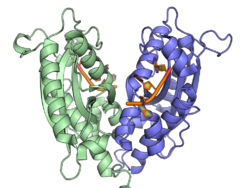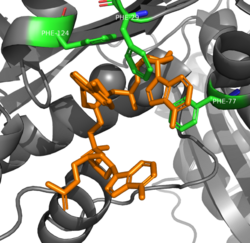Biology:Ribonuclease T
| Ribonuclease T | |||||||||
|---|---|---|---|---|---|---|---|---|---|
 A ribonuclease T dimer in complex with DNA (orange), from PDB ID 3NH1.[1] | |||||||||
| Identifiers | |||||||||
| Symbol | rnt | ||||||||
| Pfam | PF00929 | ||||||||
| InterPro | IPR013520 | ||||||||
| SMART | SM00479 | ||||||||
| |||||||||
Ribonuclease T (RNase T, exonuclease T, exo T) is a ribonuclease enzyme involved in the maturation of transfer RNA and ribosomal RNA in bacteria,[2] as well as in DNA repair pathways.[3] It is a member of the DnaQ family of exonucleases and non-processively acts on the 3' end of single-stranded nucleic acids. RNase T is capable of cleaving both DNA and RNA, with extreme sequence specificity discriminating against cytosine at the 3' end of the substrate.[1][2]
Structure and mechanism
RNAse T catalyzes the removal of nucleotides from the 3' end of both RNA and DNA. It is inhibited by both double stranded DNA and RNA, as well as cytosine residues on the 3' end of RNA. Two cytosines at the 3' end of RNA appear to remove the activity of RNAse T entirely.[3] This cytosine effect, however, is observed less with ssDNA. This lack of sequence specificity in ssDNA, combined with its ability to act on ssDNA close to a duplex region, has led to its use in creating blunt ends for DNA cloning.[4] Structurally, RNAse T exists as an anti-parallel dimer[5][6] and requires a divalent cation to function.[7]
RNAse T is able to achieve its sequence specificity in RNA digestion via several aromatic residues that sandwich between nucleobases. The π-π interactions between four phenylalanine residues and the two nucleotides at the 3' end are different depending on the identify of the nucleotides, which changes the conformation and thus activity of the enzyme.[8] An additional glutamic acid residue rotates to hydrogen bond to cytosine by not other bases, further increasing specificity.[9]
Function
A member of the larger DEDD family of exoribonucleases, RNAse T plays a key role in the maturation of tRNA[10] as well as the maturation of the 5S[11] and 23S[12] rRNA domains. Specifically, RNAse T cleaves the 3' AMP residue from the 3' CCA sequences at the end of tRNA, which explains RNAse T's sequence specificity for stopping at the 3' CC sequence.[13] Additionally, RNAse T can play a role in DNA repair by cleaving the 3' end of bulge DNA.[3]
While E. coli can survive without RNAse T, its absence leads to slower life cycles and weakened response to starvation.[14] Additionally, the presence of RNAse T in E. coli is linked to increased resistance to UV damage.[15] It has been theorized that, while other ribonculeases can perform the function RNAse T, the fact that RNAse T is more effective at cleaving DNA and RNA near double-stranded regions means that alternatives are less effective.[16] Despite the apparent usefulness of RNAse T, the enzyme is only found in gammaproteobacteria.[17]
In E. coli, RNAse T is encoded by the rnt gene and is hypothesized to have diverged from the proofreading subunits of polymerase III during the emergence of gammaproteobacteria.[16][17]
References
- ↑ 1.0 1.1 "How an exonuclease decides where to stop in trimming of nucleic acids: crystal structures of RNase T-product complexes". Nucleic Acids Research 40 (16): 8144–54. September 2012. doi:10.1093/nar/gks548. PMID 22718982.
- ↑ 2.0 2.1 "The physiological role of RNase T can be explained by its unusual substrate specificity". The Journal of Biological Chemistry 277 (33): 29654–61. August 2002. doi:10.1074/jbc.M204252200. PMID 12050169.
- ↑ 3.0 3.1 3.2 "Structural insights into DNA repair by RNase T--an exonuclease processing 3' end of structured DNA in repair pathways". PLOS Biology 12 (3): e1001803. March 2014. doi:10.1371/journal.pbio.1001803. PMID 24594808.
- ↑ "The DNase activity of RNase T and its application to DNA cloning". Nucleic Acids Research 27 (20): 4077–82. October 1999. doi:10.1093/nar/27.20.4077. PMID 10497273.
- ↑ "Escherichia coli RNase T functions in vivo as a dimer dependent on cysteine 168". The Journal of Biological Chemistry 271 (2): 1133–7. January 1996. doi:10.1074/jbc.271.2.1133. PMID 8557641.
- ↑ "Crystal structure of RNase T, an exoribonuclease involved in tRNA maturation and end turnover". Structure 15 (4): 417–28. April 2007. doi:10.1016/j.str.2007.02.004. PMID 17437714.
- ↑ "Purification and characterization of Escherichia coli RNase T". The Journal of Biological Chemistry 260 (11): 7067–71. June 1985. doi:10.1016/S0021-9258(18)88888-3. PMID 3888994. http://www.jbc.org/content/260/11/7067.
- ↑ "Aromatic residues in RNase T stack with nucleobases to guide the sequence-specific recognition and cleavage of nucleic acids". Protein Science 24 (12): 1934–41. December 2015. doi:10.1002/pro.2800. PMID 26362012.
- ↑ "Structural basis for RNA trimming by RNase T in stable RNA 3'-end maturation". Nature Chemical Biology 7 (4): 236–43. April 2011. doi:10.1038/nchembio.524. PMID 21317904.
- ↑ "Maturation pathways for E. coli tRNA precursors: a random multienzyme process in vivo". Cell 86 (3): 503–12. August 1996. doi:10.1016/s0092-8674(00)80123-3. PMID 8756732.
- ↑ "The tRNA processing enzyme RNase T is essential for maturation of 5S RNA". Proceedings of the National Academy of Sciences of the United States of America 92 (15): 6883–6. July 1995. doi:10.1073/pnas.92.15.6883. PMID 7542780. Bibcode: 1995PNAS...92.6883L.
- ↑ "Maturation of 23S ribosomal RNA requires the exoribonuclease RNase T". RNA 5 (1): 139–46. January 1999. doi:10.1017/s1355838299981669. PMID 9917073.
- ↑ "Ribonuclease T: new exoribonuclease possibly involved in end-turnover of tRNA". Proceedings of the National Academy of Sciences of the United States of America 81 (14): 4290–3. July 1984. doi:10.1073/pnas.81.14.4290. PMID 6379642. Bibcode: 1984PNAS...81.4290D.
- ↑ "The presence of only one of five exoribonucleases is sufficient to support the growth of Escherichia coli". Journal of Bacteriology 174 (20): 6682–4. October 1992. doi:10.1128/jb.174.20.6682-6684.1992. PMID 1400219.
- ↑ "Identification of RNase T as a high-copy suppressor of the UV sensitivity associated with single-strand DNA exonuclease deficiency in Escherichia coli". Genetics 151 (3): 929–34. March 1999. doi:10.1093/genetics/151.3.929. PMID 10049912.
- ↑ 16.0 16.1 "Bacterial ribonucleases and their roles in RNA metabolism". Critical Reviews in Biochemistry and Molecular Biology 54 (3): 242–300. June 2019. doi:10.1080/10409238.2019.1651816. PMID 31464530.
- ↑ 17.0 17.1 "Exoribonuclease superfamilies: structural analysis and phylogenetic distribution". Nucleic Acids Research 29 (5): 1017–26. March 2001. doi:10.1093/nar/29.5.1017. PMID 11222749.
 |


